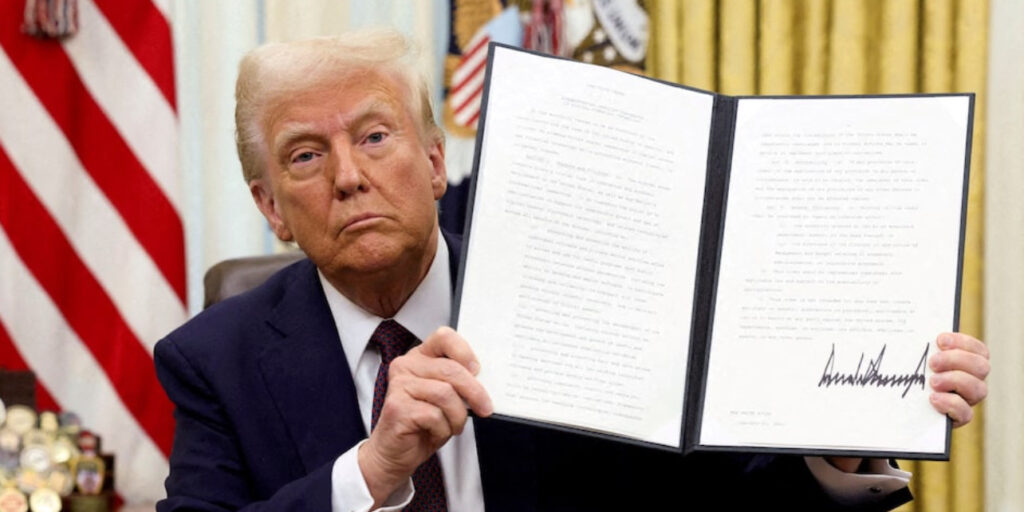US President Donald Trump has signed an executive order to create a Strategic Bitcoin Reserve, using Bitcoin already held by the federal government.
While some in the crypto market had anticipated a more aggressive buying strategy, the move is largely symbolic, acknowledging Bitcoin as a US reserve asset for the first time.
The announcement, made on Thursday, initially sent Bitcoin prices down by 5% to $85,000 before recovering to $89,200 in early European trading on Friday.
Market disappointment stemmed from the fact that the government will not actively purchase Bitcoin but will instead rely on assets obtained through civil or criminal forfeiture.
Billionaire David Sacks, the White House’s crypto czar, confirmed via social media platform X that the reserve would be built solely from seized Bitcoin holdings.
He also stated that while the government could consider acquiring more Bitcoin in the future, any such move must be budget-neutral and impose no extra costs on taxpayers.
Financial analysts note the significance of the order, despite the lack of immediate buying plans.
“The significance of this executive order is mainly symbolic, as it marks the first time Bitcoin is formally recognized as a reserve asset of the United States government,” said Andrew O’Neill, digital assets managing director at S&P Global Ratings.
While the exact amount of Bitcoin owned by the US government remains unclear, estimates suggest it could be around 200,000 BTC.
Trump’s previous endorsements of cryptocurrency had driven Bitcoin to an all-time high of $109,071.86 in January, as investors expected crypto-friendly regulations. However, Thursday’s announcement fell short of expectations, drawing criticism from industry leaders.
“This is the most underwhelming and disappointing outcome we could have expected for this week,” Charles Edwards, founder of bitcoin-focused hedge fund Capriole Investments, wrote in a post on X.
“No active buying means this is just a fancy title for Bitcoin holdings that already existed with the Govt. This is a pig in lipstick.”
In addition to Bitcoin, the US will also establish a “Digital Asset Stockpile” containing cryptocurrencies other than Bitcoin. However, these assets will also be limited to those acquired through forfeiture, with no new purchases planned.
The move comes amid Trump’s increasing support for the cryptocurrency sector, which has poured millions into his campaign and Republican candidates in the upcoming elections.
This week, Trump named five digital assets—Bitcoin, Ether, XRP, Solana, and Cardano—as potential candidates for inclusion in a government reserve. The announcement briefly boosted the market value of these tokens.
However, critics have raised conflict-of-interest concerns, as Trump’s family has launched crypto meme coins, and he holds a stake in World Liberty Financial, a crypto investment platform. The White House insists his business interests are managed separately and reviewed by ethics lawyers.
Sacks described the Strategic Bitcoin Reserve as a “digital Fort Knox”, designed to store value rather than sell assets. However, there is no clear strategy for how the reserve will benefit taxpayers.
“The US will not sell any bitcoin deposited into the Reserve. It will be kept as a store of value. The Reserve is like a digital Fort Knox for the cryptocurrency often called ‘digital gold’,” Sacks said.
Supporters argue that by holding Bitcoin long-term, the government could benefit from its potential price appreciation, preventing losses from premature sales. Sacks claimed that past US Bitcoin sales have cost taxpayers $17 billion, though this figure has not been officially verified.
Trump is expected to formally discuss his crypto policy at a White House meeting with industry leaders on Friday. While the executive order does not include direct investment in Bitcoin, it signals a growing shift toward mainstream crypto adoption in US policy.
With the 2024 election approaching, Trump’s stance on digital assets is likely to remain a key issue, shaping both market expectations and regulatory developments.


